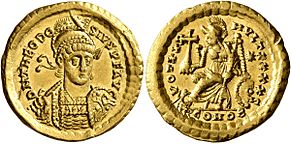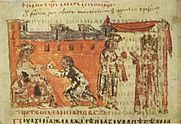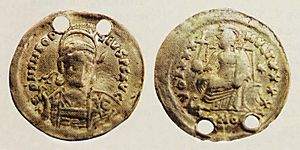Theodosius II facts for kids
Quick facts for kids Theodosius II |
|||||
|---|---|---|---|---|---|
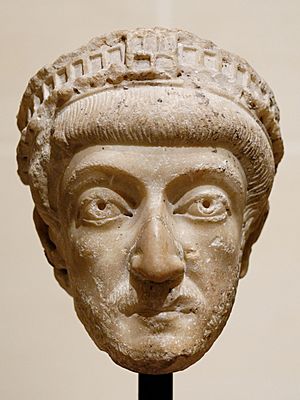
Bust of Theodosius II in the Louvre
|
|||||
| Roman emperor of the East | |||||
| Augustus | 10 January 402 – 28 July 450 (senior from 1 May 408) |
||||
| Predecessor | Arcadius | ||||
| Successor | Marcian | ||||
| Western emperors |
Honorius (402–423) Joannes (423–425) Valentinian III (425–450) |
||||
| Born | 10 April 401 | ||||
| Died | 28 July 450 (aged 49) | ||||
| Burial | Church of the Holy Apostles, Constantinople | ||||
| Spouse | Aelia Eudocia | ||||
| Issue |
|
||||
|
|||||
| Dynasty | Theodosian | ||||
| Father | Arcadius | ||||
| Mother | Aelia Eudoxia | ||||
| Religion | Nicene Christianity | ||||
| Saint Theodosius II |
|
|---|---|
| Right-Believing, Emperor of the Roman Empire | |
| Venerated in | Eastern Orthodox Church |
| Feast | 29 July |
Theodosius II (born April 10, 401 – died July 28, 450) was a Roman emperor who ruled from 402 to 450. He became emperor of the Eastern Roman Empire when he was just a baby. He took over fully after his father, Arcadius, died in 408.
His time as emperor is remembered for two big things. First, he created a famous set of laws called the Theodosian law code. Second, he built the strong Theodosian Walls around the city of Constantinople. These walls helped protect the city for many years.
Contents
Early Life of Theodosius
Theodosius was born on April 10, 401. He was the only son of Emperor Arcadius and his wife, Aelia Eudoxia. When he was only nine months old, on January 10, 402, his father made him a co-emperor. This made him the youngest person to hold the title of emperor at that time.
On May 1, 408, his father died. Theodosius was just seven years old when he became the sole emperor of the Eastern Roman Empire.
Theodosius's Reign as Emperor
Starting His Rule
When Theodosius was young, the government was managed by a smart official named Anthemius. Under Anthemius's guidance, the famous Theodosian Walls were built around Constantinople. These walls made the city very secure.
Some old stories say that the Persian king Yazdegerd I was asked by Theodosius's father to look after the young emperor. Yazdegerd supposedly treated Theodosius like his own son. He even sent a teacher named Antiochus to help raise him. Antiochus, who was from Persia, became an important person in Theodosius's life.
In 414, Theodosius's older sister, Pulcheria, became a very important figure. She promised to remain unmarried and was given the title of augusta. She acted as a guardian for her younger brother. Even after Theodosius grew up, Pulcheria continued to have a strong influence on him.
In June 421, Theodosius married Aelia Eudocia. She was a very smart woman from Athens. They had two daughters, Licinia Eudoxia and Flaccilla. They might have also had a son named Arcadius.
Helping the Western Empire
In 423, Theodosius's uncle, Honorius, who was the Western Roman Emperor, died. A new emperor, Joannes, tried to take power in the West. Honorius's sister, Galla Placidia, and her young son, Valentinian, asked Theodosius for help. They wanted Valentinian to become the Western Emperor.
After thinking it over, Theodosius decided to help. In 424, he started a war against Joannes. With Theodosius's help, Valentinian III became the Western Emperor on October 23, 425. To make the bond between the two parts of the empire stronger, Theodosius's daughter, Licinia Eudoxia, was promised to Valentinian. She later married him in 437 and became the empress of the Western Roman Empire.
Some historians believe that Theodosius was often influenced by his sister, his wife, and other officials. However, other experts argue that Theodosius was more in control of his government than people thought.
Education and Law
In 425, Theodosius founded the University of Constantinople. This was a big step for education. The university had many teachers for subjects like law, philosophy, medicine, and music. It is thought that his wife, Eudocia, who was very intelligent, encouraged him to start this university.
Theodosius also wanted to organize all the laws of the empire. In 429, he started a project to collect all the laws made since the time of Emperor Constantine I. This project was completed in 438, and the collection of laws was called the Codex Theodosianus. This law code was very important. It later became a base for the famous law code of Emperor Justinian I in the next century.
The Famous Apple Story
Theodosius's wife, Eudocia, had a lot of influence between 439 and 441. During this time, his sister Pulcheria was less involved in government. However, Eudocia's power ended because of a story involving an apple.
A historian named John Malalas told this story: One day, a man gave the emperor a very large apple. Theodosius was pleased and sent the apple to his wife, Eudocia. Eudocia then gave the apple to Paulinus, a friend of both her and the emperor. Paulinus, not knowing where the apple came from, thought it was so special it should only go to the emperor. So, he gave it back to Theodosius.
Theodosius became suspicious. He asked Eudocia what she did with the apple. She said she ate it and even swore an oath to it. Then, Theodosius showed her the huge apple. The emperor became very angry. He suspected that Eudocia and Paulinus were having a secret relationship. He had Paulinus executed. Eudocia asked to be sent away to Jerusalem. Around 443, the imperial couple separated, and Eudocia lived in Jerusalem.
Wars and Challenges
The Eastern Roman Empire faced many challenges during Theodosius's reign.
- Wars with Persia: In 420, there was a war with the Persians because they were persecuting Christians. The war ended without a clear winner.
- Dealing with the Huns: The Huns were a powerful group who often raided the empire. The Romans tried to keep peace by paying them gold. In 424, they agreed to pay 350 pounds of gold. When Attila became the leader of the Huns, this payment was doubled to 700 pounds in 433. The Huns defeated Roman armies in 443. Theodosius had to agree to pay a huge annual tribute of 2,100 pounds of gold to keep them from attacking. In 447, the Huns attacked the Balkans and reached close to Constantinople.
- Helping the West against the Vandals: When the Vandals took over Roman Africa in 439, Theodosius sent forces to help the Western Empire. However, this plan failed.
Religious Debates
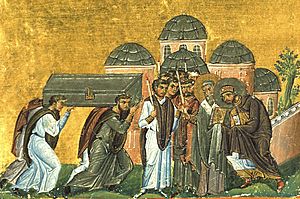
Theodosius often tried to solve big arguments about the nature of Christ. He appointed a monk named Nestorius as the archbishop of Constantinople in 428. Nestorius became involved in a debate about how to describe the Virgin Mary. Some called her Theotokos ("birth-giver of God"), while others disagreed. Nestorius suggested Christotokos ("birth-giver of Christ") as a middle ground, but it did not work.
Nestorius was accused of separating Christ's divine and human natures too much. This idea was later called Nestorianism. Theodosius called a big meeting, a council, in Ephesus in 431 to settle the issue. The council decided against Nestorius, and he was sent away.
About 20 years later, another religious argument started. This time, it was about a monk named Eutyches. He believed that Christ's divine and human natures were one. Another council was held in Ephesus in 449. This council supported Eutyches, but many bishops, including Pope Leo I, disagreed. The emperor supported the council's decision. However, after Theodosius died, these decisions were changed at the Council of Chalcedon.
Theodosius's Death
Theodosius died on July 28, 450. He passed away after a riding accident. Soon after his death, his sister Pulcheria married the new emperor, Marcian.
Theodosius was buried in the Church of the Holy Apostles in Constantinople. This church was a special burial place for emperors.
Theodosius II is remembered as a Saint in the Eastern Orthodox Church. His feast day is July 29.
See also
 In Spanish: Teodosio II para niños
In Spanish: Teodosio II para niños
- List of Byzantine emperors
- Theodosian dynasty


